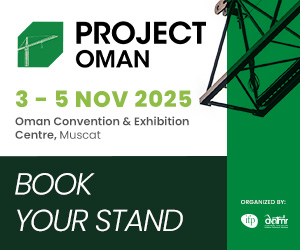The development, construction, operation and maintenance phases of the Oman National Railway Project promise to spawn a bonanza of investment and business opportunities encompassing virtually all aspects of the multibillion-rial venture. Opportunities associated with the mammoth project were outlined at a well-attended national symposium organized by the Ministry of Transport & Communications. Transport & Communications Minister Dr Ahmed bin Mohammed al Futaisi underlined the project's potential to serve as a powerful enabler of transformational national development.
A sense of the sheer physical scale of the project was provided by a senior representative of Italffer (Gruppo Ferrovie Dello Stato Italiane), the engineering consultancy arm of Italian Railway, which was recently awarded a contract by the Omani government to provide Preliminary Design Consultancy services linked to the Oman National Railway Project.
According to Luka Beccastrini, Middle East Regional Head of Italferr, construction of the 2,244km national network traversing the length of the Sultanate will require the supply of an estimated 12,000 kilometers of rail. In this regard, a rail production plant in the Sultanate, designed and equipped to produce high quality rails, will not only be viable, but also lucrative in terms of catering to the future maintenance requirements of the network, he said. Further, the requirement of an estimated 10.2 million concrete sleepers to be laid all along the length of the network gives rise to the potential need for at least five production plants to be established at key locations along the alignment. Output from a medium sized plant is about 300,000 sleepers per year, he said.
In his presentation, Beccastrini also underlined the potential for investment in at least 10 quarries for mining stone required for the estimated 23 million cubic meters of ballast and sub-ballast required for the project. Opportunities for investments in associated crushing and screening plants, and concrete batching plants, are promising too, he said. Listing other business prospects, he said significant investments will be required in the establishment of plants and facilities for civil works. In this regard, he underlined the potential for entire townships to mushroom at worksites expected to emerge at intervals of between 50 — 100 km alongside the alignment.
Stockyards for the storage of large quantities of construction material, such as soil for embankments, granular material, ballast and precast elements, are envisaged as well. Beccastrini also foresaw the potential for investments in precast plants to be set up close to major structures planned along the route. These facilities are necessary for the fabrication of viaduct slabs, double walls, façade elements, noise barrier walls, prefabricated cells and concrete sleepers.
Opportunities also abound across other elements of the gigantic project, he said. Given the undulating terrain through which the alignment runs, a staggering 1.7 billion cubic meters of cut-and-fill will be required, along with some 20.250 million cubic meters of earthworks. The project scope also calls for 60 million square meters of geotextiles, 2.250 million meters of drainage pipes, 13,500 manholes, 3,000 kilometers of unmetaled roads along the right-of-way, 1,000 kilometers of paved dual carriageways, 6,500 kilometers of security fencing, 1,200 pedestrian gates, and 300 vehicle gates – requirements that will fuel demand for investment in facilities and services, the expert said. Underscoring the magnitude of the construction work at hand, an estimated 35 kilometers of tunnels will be required to be built along the network, in addition to 45km of viaducts, 39 kilometers of rail bridges and 48 kilometers of wadi bridges. Scores of other structures will be built en route as well, including 245 flyovers and underpasses, 98 pedestrian crossings and 310 animal crossings.
Likewise, the massive project foresees a plethora of contracting, business and investment opportunities in the development of stations, depots and maintenance yards along the route. A master plan envisages the construction of 30 small stations, 10 intermediate stations, six large stations, eight marshaling yards, nine intermodal yards, five rolling stock service facilities, 3 heavy duty maintenance workshops, six central maintenance workshops, one main operational control center and six operational control centers. Substantial outlays will also be required towards rolling stock for freight and passenger transportation. Rolling stock needs include 40 freight locomotives, 30 shunting locomotives, 5 recovery locomotives, 30 diesel multiple units (DMU) for passengers, 15 diesel locomotives for passenger trains, 80 passenger coaches and 500 freight wagons of all kinds.
Oman Daily Observer
16 September



















































































